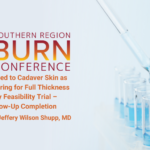Abstract | December 20, 2021
Fish Skin Compared to Cadaver Skin as a Temporary Covering for Full Thickness Burns: An Early Feasibility Trial – 12 Month Follow-Up Completion
Learning Objectives
- Compare the storage requirements and availability for fish skin and cadaver skin.
- Describe the difference of Omega3 content in fish skin and cadaver skin.
- Describe the potential role the Omega3 fatty acids might have in the reduction of pain and control of inflammation in burns and other wounds.
Introduction:
Full-thickness thermal burns may require staged procedures with temporary covering to ensure the wound bed is optimized for autografting. Fish skin grafts* can serve as a potential dermal substitute for thermal injury. These are made from freeze dried, sterilized, decellularized skin of North Atlantic cod (Gadus morhua). The gentle processing of the fish skin reduces the risk of viral disease transmission to humans and retains its naturally occurring Omega3 fatty acids which are known for their pain and inflammation modulating effects. While fish skin grafts have been cleared by the FDA as a medical device for use in acute, surgical and chronic wounds and partial thickness burns, additional research into its effect in full thickness burn injury is needed. The purpose of this clinical trial is to assess the safety and efficacy of fish skin grafts as an alternative to cadaveric skin (standard of care) for temporary coverage in the setting of a full-thickness burn requiring staged grafting.
Methods:
Following debridement, subjects with full thickness burns were randomized to have two adjacent areas (70-140 cm2 each) covered with fish skin graft or cadaver skin for 7 days. The subjects then received a split thickness skin graft (STSG). Wound closure (100% re-epitheilization) at each site was assessed weekly for 3 weeks, and scarring and quality of healing was assessed at 3 and 12 months post STSG. Pain was measured at all time points by a visual analogue scale (VAS). Biopsies obtained from a subset of these patients (n=2) were Hematoxylin and Eosin (H&E) stained and analyzed to examine histoarchitecture of the treated wounds and assess epidermal and dermal thickness and cellularity.
Results:
Five patients were enrolled and treated with both Fish Skin and Cadaver Skin. Time to 100% healing, patient assessed quality of wound healing, and Vancouver scar scale show a tendency for better performance for fish skin grafted areas, but no statistical significance was detected between treatment groups. Pain rating was comparable for both areas. At days 14 and 21, fish skin treated biopsies had slightly greater epidermal thickness than allografted sites, however no statistically significant differences were seen in epidermal thickness between allograft and fish skin-treated samples. Cadaver treated skin samples had greater cellularity than fish skin-treated samples along the same time frame. Graft failures were observed in two cadaver skin covered areas and one partial failure in a fish skin covered area.
Conclusions:
At 12 months post STSG, the results from this trial indicate that the decellularized fish skin grafts result in a good outcome and are both safe and non-inferior to cadaver skin as an early cover for full thickness burns but a larger clinical study is warranted.

